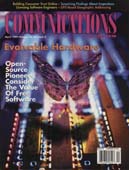April 1999 - Vol. 42 No. 4

Features
Practical Programmer: Inspections?Some Surprising Findings
Sharing Standards: IT Skills Standards
Viewpoint: Taking the Lead in Licensing Software Engineers
ACM Digital Library Enhancements
Lessons from Open-Source Software Development
The Origin of the Camel Lot in the Breakdown of the Bilingual -Unix
Shared Leadership in the Apache Project
Following the Path of Evolvable Hardware
Field-Programmable Gate Arrays
Evolvable Hardware Chips For Industrial Applications
Hardware Evolution System AdAM
Experiments on Evolving Software Models of Analog Circuits
Analysis of -Unconventional Evolved Electronics
Building Consumer Trust Online
GPS-Based Geographic Addressing, Routing, and Resource Discovery
Top Management Toolbox For Managing Corporate IT
OO Distributed Programming Is Not Distributed OO Programming
Inside Risks: Just a Matter of Bandwidth



